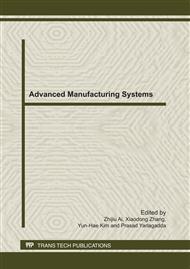p.448
p.452
p.458
p.462
p.477
p.483
p.487
p.491
p.496
Study on the Lubrication and Antifriction Mechanism of Low Frictional Self-Lubricating Wear-Resisting Coating
Abstract:
This paper is about the lubricating wear-resisting coating KF301/WS2 and round pit texturing modified coating KF301/WS2 which are prepared by supersonic plasma spraying, laser remelting and surface texturing technology, tribological characteristics of two kinds of coatings are studied under room temperature, according to this, it is discussed for lubrication antifriction mechanism. The research shows: round pit texture has a certain influence on friction factor of coating’s surface and abrasion loss. Friction coefficient of untextured surface is about 0.0138 in the initial stages, while friction coefficient of round pit texture is about 0.01, compared with the former, the latter decreases 27%; when wear time reaches to 1 hour, abrasion loss of untextured surface is 0.0026mg, while abrasion loss of round pit texture is about 0.013mg, compared with the former, the latter decreases 50%. The lubricant antifriction performance of round pit texture is higher than untextured surface, this is because friction coefficient of coating is decreased as the change of the third-body bed, and round pit micro moulding can collect abrasive particle, decreasing the influence of abrasive particle.
Info:
Periodical:
Pages:
477-482
Citation:
Online since:
September 2011
Authors:
Price:
Сopyright:
© 2011 Trans Tech Publications Ltd. All Rights Reserved
Share:
Citation:


